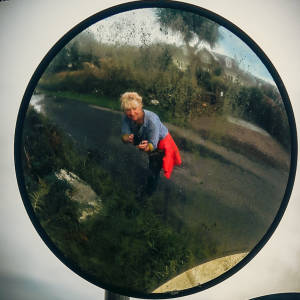Cillín
I hold a single white sheet, a map
traced edges of this country, its counties and borders;
there is no blue for rivers, no red for roads,
no elevations or compass to orientate
only the flat outlines of terrain
and black circles,
so many they form, thick clouds in the West.
There is a single legend to decode: cillín
underneath spaces, ground to forget, beyond words or maps.
Here, under seeling night and hard stars
where mists shroud and winds wipe
meaning from weathered stone.
wind-bent hedgerows twisting from trunks
as if to look away, a place
where everything moves to forget.
The men came
between dusk and dawn
delivering the unnamed infants to the clay
unwilling midwives at boundary ditches, crossroads, holy wells,
outside churchyards, beneath standing stones,
in fields with lost names -
Infants' Hollow, Corpse Field, Strangers' Hill.
There are other rifts
lost telling in the sediments here,
all that mother ache from dark rooms
still humid with the heat of birth and blood
their weightless bundles, like birds' pneumatic bones,
taken from them,
small bodies they never held
names they were told they could never speak.
Their grief shadows this place
in mist, steeped into stalk and blade
in the soft ground
all they were told they could not say
sod-choked and searching,
the map's black circles, deep wells we can never know.
But we have these dark co-ordinates
because they could not but remember
and sought others, troops of lost children, to lay theirs beside
and set stones in the gouged ground
to say you were mine.
Alone with the spade and the night
they spilled the sun's stones,
the griancloiche , gathered from the river bed,
around the small bodies planted there,
seams of glinting silver to light their infants' sky
to blink towards others lost there
to map them on a landscape
to say they were here.
Una Mannion: a landscape for forgetting
When we were in Dublin recently we went to an excellent photographic exhibition on Cillíní - burial places for the unbaptised, usually babies, who were not allowed to be interred in consecrated ground. The photographs were wonderful, taken at night when the babies had to be buried, respectful, harrowing and beautiful. This poem accompanied the images.
Cillíní are everywhere, some now recognised and tidied up, others forgotten as this one, tucked into a little copse by a field boundary. How shocking to see so many little grave markers, desperate reminders of the harshness and cruelty of a church that would not allow unbaptised babies, those who had died by suicide or strangers to be buried in consecrated ground.
An interesting article here
Sorry for this rather gloomy offering but it makes you think. Thankfully times are more compassionate now.
Chips and arthouse tonight - Papi Chulo . Will catch up tomorrow!

Comments
Sign in or get an account to comment.


